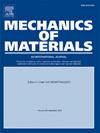Experimental testing of V notched radially graded materials under static loading
IF 3.4
3区 材料科学
Q2 MATERIALS SCIENCE, MULTIDISCIPLINARY
引用次数: 0
Abstract
The growing interest in additive manufacturing and printed materials has opened new possibilities for the development and application of Graded Materials (GMs). However, capturing the strength and fracture behavior of GMs presents challenges, as the extent to which classical theories for homogeneous materials apply remains uncertain. For example, it has been recently suggested that in the classical problem of a sharp wedge or crack loaded in-plane (mode I and/or mode II), the stress singularity can be mitigated by grading the elastic properties of the material near the notch tip according to a power-law distribution, . This suggests that sharp geometrical discontinuities can exist without causing sharp stress concentrations. Under these conditions, it is conceivable that structural optimization should aim to achieve uniform stress distribution or, more specifically, consistent strength throughout the material. Since material resistance typically follows a power-law function of the elastic modulus, a state of uniform stress is not optimal. However, a state of uniform strength may also be considered less than ideal with respect to the homogeneous material since the softer material used to reduce stress concentration reduces also the strength of the specimen. Here, we report experiments conducted on V-notched specimens, varying the grading exponent , and compare the results for homogeneous material specimens with those of GMs. We find that the cancellation of singularity effect competes with the reduction of strength due to the use of softer materials, but when the latter effect is accounted for or reduced, we observe an improvement compared to the homogeneous V-notched case. Further, when the strength-modulus exponent , structural optimization is equivalent to minimizing stress concentration. For most materials with , the optimal behavior occurs near this criterion. In our case, we found , which is significant because strain energy density, a function of both stress and strain, acts as a dual-purpose criterion. This criterion is similar to the ratio used in homogeneous materials like Rankine or Von Mises. Notably, in fatigue tests, we anticipate that the benefits of material grading will be more pronounced.
静载荷作用下V形缺口径向梯度材料的试验研究
人们对增材制造和印刷材料的兴趣日益浓厚,为梯度材料的开发和应用开辟了新的可能性。然而,捕获GMs的强度和断裂行为存在挑战,因为均质材料的经典理论适用的程度仍然不确定。例如,最近有人提出,在平面内加载尖锐楔形或裂纹(I型和/或II型)的经典问题中,可以根据幂律分布E ~ rβ对缺口尖端附近材料的弹性特性进行分级,从而减轻应力奇异性。这表明尖锐的几何不连续可以存在而不引起尖锐的应力集中。在这些条件下,可以想象,结构优化的目标应该是实现均匀的应力分布,或者更具体地说,在整个材料中实现一致的强度。由于材料阻力通常遵循弹性模量的幂律函数,因此均匀应力状态不是最佳状态。然而,相对于均质材料,均匀强度的状态也可能被认为不太理想,因为用于降低应力集中的较软材料也会降低试样的强度。在这里,我们报道了在v形缺口试样上进行的实验,改变了分级指数β,并将均匀材料试样的结果与GMs的结果进行了比较。我们发现,由于使用较软的材料,奇异效应的消除与强度的降低是竞争的,但是当后者的影响被考虑或减少时,我们观察到与均匀的v形切口情况相比有改善。当强度-模量指数m=0时,结构优化相当于使应力集中最小化。对于大多数具有m<;1的材料,最佳行为发生在该准则附近。在我们的例子中,我们发现m≈0.5,这是重要的,因为应变能密度是应力和应变的函数,可以作为双重标准。这个准则类似于在均匀材料中使用的σ/σa比率,如朗肯或冯·米塞斯。值得注意的是,在疲劳试验中,我们预计材料分级的好处将更加明显。
本文章由计算机程序翻译,如有差异,请以英文原文为准。
求助全文
约1分钟内获得全文
求助全文
来源期刊

Mechanics of Materials
工程技术-材料科学:综合
CiteScore
7.60
自引率
5.10%
发文量
243
审稿时长
46 days
期刊介绍:
Mechanics of Materials is a forum for original scientific research on the flow, fracture, and general constitutive behavior of geophysical, geotechnical and technological materials, with balanced coverage of advanced technological and natural materials, with balanced coverage of theoretical, experimental, and field investigations. Of special concern are macroscopic predictions based on microscopic models, identification of microscopic structures from limited overall macroscopic data, experimental and field results that lead to fundamental understanding of the behavior of materials, and coordinated experimental and analytical investigations that culminate in theories with predictive quality.
 求助内容:
求助内容: 应助结果提醒方式:
应助结果提醒方式:


